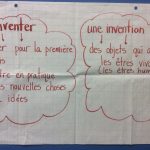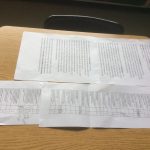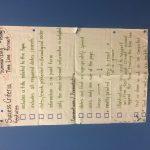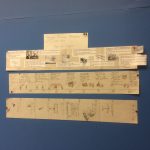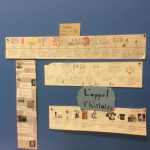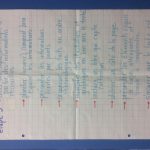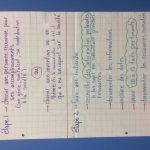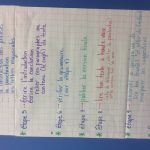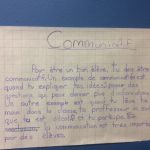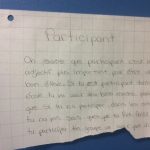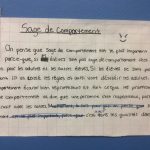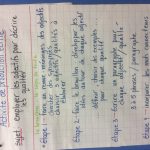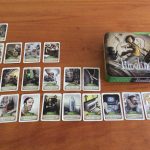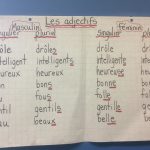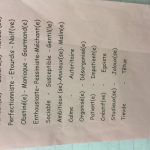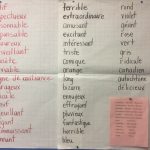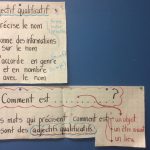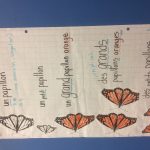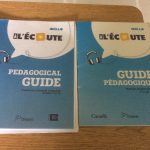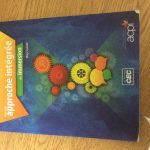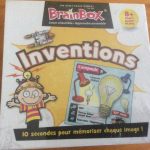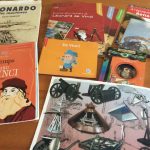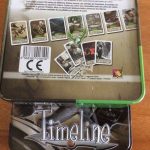- To develop consistent practice using balanced literacy and cross-curricular integration (primarily focusing on language arts, social studies, science) in the French immersion classroom
- To support students’ language acquisition and enhance students’ French communication skills across subject areas, rather than teach subjects in isolation
Listening (compréhension orale)
Speaking (production orale)
Reading (compréhension écrite)
Writing (production écrite)
- To integrate the use of school board-issued iPads into curriculum taught in French to support students’ creativity and innovation when demonstrating their knowledge and understanding
- To source for apps/sites/resources to support the French cross-curricular units
- To use iPads for more than simply accessing the Internet for research or as a word processing tool
Team Members
Lisa Ilowski
Avon Maitland District School Board
Joan Garner-Flood
Avon Maitland District School Board
Ashley McNeil
Avon Maitland District School Board
Marie-Josee Houle
Avon Maitland District School Board
Professional Learning Goals
- Further developed our collaborative skills within the TLC process, and subsequently with the rest of our immersion colleagues and, by extension, all colleagues
- Maximized the efforts of the immersion team by working together; developed a bank of resources (apps, websites, units, tasks) and a forum for sharing, to enhance teaching practice (“Work Smarter, Not Harder”)
- Using balanced literacy and cross-curricular integration, teachers were able to cover required areas of the curriculum by developing rich, meaningful tasks for students; teachers had the opportunity to provide feedback, assess and evaluate student work for multiple areas of curriculum within the same task
- Integrated technology into more (all) areas of the immersion program so teachers were required to take risks and develop their own skills
- Helped support newer teachers in their role as immersion teacher so they weren’t overwhelmed by the curriculum and demands of the job
Activities and Resources
Our TLC proposal developed out of the following questions:
- What do we already do that works well?
- What do we feel is the most challenging part of delivering the French immersion program?
- What types of resources do we have?
- What types of resources do we need?
- What types of professional learning/development have we already engaged in and found to be most useful for our needs?
- What types of professional learning/development have we already engaged in and found to be not very useful for our needs?
Based on the discussion generated around these questions, our team decided we would use our TLC funding to attend a professional conference, and have release time to collaborate and source for relevant resources. Each of these three areas is explained further:
Attend a Professional Conference
ACPI (Association canadienne des professeurs d’immersion) hosts an annual professional conference which is held in a different province or territory each year. The 2016 conference was being held in Niagara Falls, Ontario, which made attending this conference a realistic and affordable opportunity. In October 2016, three members of our team attended the annual conference. The professional learning that this conference provided was amazing! The theme of the conference was, “Rendez-vous au carrefour de l’immersion!”.
During the conference, each of us attended different workshops in order to maximize tapping into the vast range of topics that were addressed.
At the conference, we received or purchased a number of useful resources. One professional resource in particular became a mentor text, Vers une approche intégrée en immersion by Roy Lyster (Les éditions CEC). The entire text relates to the main focus of our TLC which is creating an integrated approach within the French immersion classroom. This text is written in an easy to read and understand manner and covers pedagogical theory and practical classroom applications of how to create an integrated French immersion classroom learning experience that benefits students and teachers. There is a DVD showing real-life applications in a classroom, and some reproducible documents included as well.
Use Release Time to Collaborate
In addition to attending the professional conference, our team met on four different occasions between October and May. During our meetings, we discussed strategies we were using in the classroom to integrate curriculum areas, identified challenges we were facing, provided possible solutions to try, shared assessment and evaluation practices, outlined features of some resources we had tried, and sourced for new resources.
Source for Relevant Resources
- Ontario Ministry of Education Curriculum documents
- La littératie en action (French Language Literacy Program ERPI)
- Les Nouvelles/Le Monde en Marche – Les Plans Current Events subscription
- Common European Framework Reference (CEFR)
- DELF kits
- “Un jour, une actualité” – Internet current events site
- l’Encyclopédie canadienne/Canadian Encyclopedia – Internet-based resource
- School iPads
- Apps – Spark Video, Recordings, Google Classroom, Explain Everything
Unexpected Challenges
As a team, we do not feel that there were any activities that were not helpful in meeting our goals. Our main goal was to collaborate, and we did that.
The main challenge our team faced was time. Our primary motivation and our enthusiasm to participate in this TLC was to access release time to work together, which we did, but, it turns out, in our desire to really dive into this topic, we would still need more time.
The mentor text that we used had so much relevant information, but we could have spent all of our release time exploring this single resource.
During our meetings, we engaged in rich discussion by sharing what we were each trying in our classrooms regarding a balanced literacy, cross-curricular approach. Very often, we were able to offer suggestions and troubleshoot possible strategies to go back and try. After every meeting, each of us was able to go back into our classrooms with an idea of something different that we were going to try next with our classes, as well as further instructional tools to use in our teaching. At the beginning of our TLC, we thought we would have developed a continuum or developed lessons/units for a cross-curricular immersion program, but this was not achieved within the timelines of our TLC. We have parts of things, but further compilation is needed.
Exploring different apps and Internet sites was very helpful, but again, just this aspect of our TLC could have consumed all of the release time.
Enhancing Student Learning and Development
Through our discussions, one of the key challenges we identified is that when students are working on assignments, they tend to gather/research information in English, and then try to translate this material into French. This is a multi-layered problem since immersion students typically do not have the level of French needed to be able to translate content-heavy English material. Because of this, students resort to using translation programs such as Word Reference or Google Translate. As a result, the work produced is not an authentic representation of the student’s French language skills and/or the work is incorrectly translated because it is out of context.
As immersion teachers, we are very aware of the need to develop students’ understanding that there will be a disconnect between their ability to communicate in French compared to their English communication skills. We recognize the importance of including oral language (listening and speaking) opportunities as much as possible. After all, children learn to talk before learning to read and write. We need to help students understand that over time, especially through cross-curricular integration, as they develop their French language skills, the disconnect between their English and French skills will decrease.
In our TLC, we decided to explore ways in which we could help alleviate this challenge for junior students. This does involve a considerable amount of work on the teacher’s part, at the outset. For example, one strategy is to search out a number of appropriate (kid-friendly, en français ) websites that would be relevant to the topic(s) students will be working on (e.g., gr. 6 la biodiversité, gr. 5 le gouvernement). Students are then limited to using these sites rather than facing the limitless possibilities on the Internet.
Another option is to direct students to use sites that are bilingual (e.g., l’encyclopédie canadienne). In this manner, students may read the English content but, when they select a section to use (e.g., for jot notes), they can easily click on the French version of the text to see the accurate translation for the purposes of their information gathering. In doing so, students are refraining from using translation programs or apps that do not provide an accurate context for the student’s work.
Also, in our TLC, we recognized the need to anticipate the vocabulary and language structures (e.g., verb tenses) that students will need for specific units of study. The goal of this is not to provide isolated lists of vocabulary or a verb rule that students should try to use, but rather for the teacher to select appropriate resources, and develop curriculum content lessons and activities that consistently incorporate this vocabulary or language skill so students have ongoing opportunities to use the vocabulary and structures.
From our experiences with our classes, the members of our TLC found that incorporating French videos and songs into the learning cycle also increases student engagement and exposes students to authentic French speakers. Initially, students may feel they don’t understand when they hear a native French speaker but, by offering multiple opportunities for listening, students learn skills at decoding what they hear and concentrate on understanding the overall meaning rather than concentrating on each specific word. The teacher can build numerous activities around the listening of French videos and songs that reinforce language acquisition skills and curriculum content acquisition.
In our school’s immersion program, junior students have a minimum of 600 minutes of total language instruction which is divided equally between French and English. Through our collaboration, we all agreed that a first step and key element to promote cross-curricular student learning in an immersion classroom is to teach English language arts curriculum in conjunction with French language content. For example, if students are studying persuasive writing techniques in English, they should also be doing this in French so both content areas reinforce each other. Showing news/documentary clips (compréhension orale) about appropriate, but controversial, topics could be used to introduce different points of view. The teacher could select, in advance, a variety of texts in both French and English that students will read (compréhension écrite) and identify the arguments presented. In doing so, hopefully students will develop deeper understanding of related skills (e.g., using transition words, writing in the first-person to communicate an opinion, thinking of counter-arguments when presenting an opinion). A further example of cross-curricular integration would then involve having students write (production écrite) their own persuasive argument as a letter or article/report about topics being studied in science or social studies (e.g., Wind Turbines; For or Against, Should Exotic Animals Be Allowed as Pets). From there, a class debate (production orale) could be organized or students could create (media literacy) their own videos, songs or newscasts using an app such as Spark Video.
In our school’s immersion programs, most homeroom teachers have their class for French and English language arts. Because we have our class for most subject areas, it is much easier to develop a cross-curricular approach. If a subject area such as social studies or science is delivered by a rotary teacher, there is considerable co-planning effort required on the part of all of the teachers involved.
When developing cross-curricular tasks, the balanced literacy component is essential. In doing so, students will benefit by having fewer culminating tasks to complete, but tasks that are multi-layered. For teachers, such tasks incorporate a greater target of skills that can be used for assessment and evaluation purposes.
Despite the fact that we found that there is considerable planning to be done at the outset for effective cross-curricular instruction, we all feel the benefits are worth it. Once in place, the planning can be re-used, modified and added to, depending on the changing needs of the student group, while the overall themes remain the same. As well, for the teacher, the process of cross-curricular planning becomes easier over time.
Sharing
We have shared some of our project work with immersion colleagues in our schools.
For two of our group members, the project work aligned with tasks we were developing in our school-based immersion professional learning community (PLC) which is developing grade benchmark tasks (production orale, production écrite) based around reading for information (compréhension écrite).
Another member of our TLC was involved in a school-based PLC that focused on finding Internet-based audio/video resources primarily to support the “compréhension orale” component of the French immersion program across the primary and junior grade levels.
In a previous year, we participated in a French immersion PLC that created a blog for French teachers in our board, but we realized that since its creation, very few teachers take the time to go to the blog or to post things onto the blog. It seems that the preferred method of sharing is using Google Drive with our school board-issued Gmail accounts. There is a French immersion folder that all immersion teachers have access to and which we have agreed to use for materials created.
We will have opportunities to share our project work with our colleagues at the end-of-year division meetings in our schools. As well, we will be able to contribute our TLC collaboration work as part of the French PLCs that we anticipate being again involved in next year at our schools. One of our TLC members is also the French facilitator for the school-based PLC and will be able to share the TLC work with other French facilitators at the first organizational meeting in the fall.
Project Evaluation
Did We Meet Our Goals and How We Determined Success?
Attending the ACPI professional conference was a highlight of our collaboration as there are few professional opportunities specifically designed for French immersion teachers. Going to this conference was so motivating and reassuring! We were able to connect and interact with teachers from all over Canada (and some from the United States). We also realized that the challenges we face are not unique to us in our school and board. From the conference alone, we took away renewed enthusiasm and motivation to keep striving for new things in our careers as French immersion teachers. It was a terrific way for our TLC group to bond and really get into the mode to jump into our TLC project over the past months. We also went back to our schools with resources and ideas we could immediately implement in our classrooms.
We were definitely successful at further developing our collaborative skills via the TLC process. For each of our meetings, we began by identifying what we hoped to accomplish in that session, and provided time for everyone to contribute whether by sharing what they had been doing in their class or by asking the group for suggestions, feedback, etc. It was a very meaningful conversation for all participants. Despite the fact that the TLC itself has come to an end, we are committed to further collaboration together and look forward to such opportunities.
“Work Smarter, Not Harder”: As a team of four teachers involved in this TLC, we were definitely able to maximize our efforts by working together. Although we do not all teach the same grade or in the same school, through our discussions we realized we were encountering the same challenges and were able to share our strategies. As a result, we each had multiple ways to address the issues. Furthermore, now that the door to open-communication and collaboration is wide open, there is a collective willingness to keep that door open.
As immersion teachers, we find that we often need to create our own resources or modify resources that are intended for francophone students. Through the TLC, we opened up more communication about what we were creating and from there willingly shared any resources we created or had found that could be useful. For example, in each of our schools we receive the same current events subscription or use the same literacy programs. We realized that each teacher was creating their own tasks around these resources. We also realized that it is as simple as reaching out to each other to ask, “Hey, I’m doing this article or text. Do you have any activities that you have made?” or “Here is a copy of the unit activities and rubrics I’ve prepared for the biodiversity unit.” In doing this, the goal is not to simply create a one-size fits all approach, but instead to offer a starting point that can be modified to the needs of the teacher and their class. Rather than post our created resources or links in a blog, we found the easiest way was to share with each other using Google apps or our school board email. Each teacher then stores the resources in their own preferred manner.
We definitely feel we have experienced varying degrees of success using balanced literacy and cross-curricular integration, but this will remain an area for further growth that each of us continues to pursue in order to say it is a consistent practice. Three of us have a homeroom class and are using many aspects of balanced literacy cross-referenced with at least one science or social studies unit. This implementation was more of a work in progress that evolved, rather than one that was planned from the outset and then put into practice. Moving forward, we each feel that we will use the balanced literacy and cross-curricular approach for planning science and social studies units next year. From there, we hope to create a formalized continuum or overview that compiles our work and can be shared with each other (and others). As stated earlier, in the context of how our school’s immersion programs are set up, we feel the most important first step is to cross-reference the French and English language arts components, and then build in the integration of science and social studies.
We do feel that it is a lot of planning at the start, for teachers, but that in conjunction with a backwards design process, the cross-curricular and balanced literacy approach helps to ensure tasks are more meaningful and engaging for students. In doing so, there is definitely greater opportunity to provide meaningful feedback, assess and evaluate student work for multiple areas of curriculum within the same task. Students were more invested in the learning process and striving to apply their learning when they knew the culminating task held greater weight than numerous disconnected tasks.
We told our students about our TLC work. Students were excited and surprised to learn that teachers engage in such learning. They respected what we were doing and would ask us about our meetings. We think this encouraged them to invest in their own learning by supporting us, as their teachers, with our learning process.
Although the members of our TLC group are at different levels of integrating technology into the immersion program, each one of our group members does integrate technology to some degree on a daily basis and is willing to take risks and develop their own skills. Each group member uses the iPads in ways to support student creativity and that enables the teacher to assess different content areas (e.g., Spark Video – media literacy, French production écrite et production orale).
Three of our group members have 15 to 23 years of experience in teaching, while one of our group members is in her third year of teaching. Despite these differences in experience, we realized that we all feel overwhelmed by the curriculum and demands of the job. Through the TLC, we loved having the opportunity to share and support each other. The more seasoned teachers could provide insight gained through experience, and the newer teacher could share insight through fresh eyes, new ideas, technology tips and the excitement that accompanies starting a career journey. Overall, each member of our group was very eager to work together in our TLC learning journey and sees herself as a learner alongside the students in our classes.
What We Might Have Done Differently
If starting the TLC process over, we would organize our meetings differently and try the following:
Using the curriculum, we would select a specific science or social studies unit for a junior grade. As well, we would select the specific English language arts content and French language goals (grammatical structures, verb tenses, etc.) that would be embedded into the learning cycle.
From this point, we would collaborate to develop a cross-curricular, balanced literacy learning cycle. As a team, we would all work on creating this one exemplar unit by collaborating together through the planning process.
Incorporated into this, we would go through this process using specific pedagogical suggestions and approaches from the mentor text. We would even set a timeline for reading the mentor text in order to fully embed the learning from the mentor text into our TLC.
As part of the process, we could divide up the tasks of sourcing the relevant resources, developing the rubrics, creating the learning tasks, and report card comment(s) reflective of the learning cycle and specific curriculum. This would probably take at least two meetings, possibly three, but this could possibly still be ambitious in that time frame.
Ultimately, each of the teachers in the team would be able to develop further cycles of learning using the same process, after having collaborated together. From this point, the tasks could be implemented by one/all of the teachers if appropriate for their grade.
The final meeting(s) would take place after a period of eight to 10 weeks upon completion of each teacher having implemented a learning cycle. Any subsequent meeting(s) would provide opportunities for the TLC team to moderate, debrief, share, etc. about their experience. Any remaining time would be focused on making modifications to the learning cycles based on the experiences of the teachers. At the end of the process, a continuum of learning or at least three further learning cycles would be created as a result of the group’s work.
We were unable to achieve creating a continuum of learning or set of units as part of our TLC goals. In retrospect, while we fully value how we used our meeting time, we wish we had a concrete, summative learning cycle of work to reflect our process. As it stands, it is now up to each member to independently continue developing, or create integrated units for next year, based on the discussion and learning that we did together. However, that being said, the manner in which we organized our time did lend to a very flexible approach that evolved in real time and provided the content for rich collaborative discussion over a period of months.
We see the value that having a more structured format for the collaborative meetings could have. That being said, we would not want an overly structured process to impede the collaborative process.
Resources Used
TFO IDÉLLO À L’ÉCOUTE Guide pedagogique
Français langue seconde 1re à 12ème année
Free video capsules, pedagogical sheets in French and English for FSL teachers linked to Ontario Ministry of Education FSL curriculum
Vers une approche intégrée en immersion
pour améliorer les compétences communicatives des élèves en immersion
Author Roy Lyster, published by Les ÉDITIONS CEC
$40
ISBN 978-2-7617-8901-1
Publications LesPlan
subscription ($95 for 4 months or $195 for 8 months)
subscription can be used for all teachers within one school, and the students in those classes
Well worth the investment! For grades 5 and 6 immersion, we subscribe to “Nos nouvelles”
Nos Nouvelles / The Canadian Reader est une ressource sur l’actualité prête à l’emploi destinée aux élèves à partir de la 3e année.
Games –
“Timeline” version “Inventions” and “Multi-thèmes”
Creator Frédéric Henry
Timeline: Inventions is a card game played using 109 cards. Each card depicts an invention on both sides, with the year in which that invention was created on only one side.
Can be ordered online
Easily adapted for whole class use to create timelines, sequence, practise saying numbers, years and to use as a springboard for oral conversation or research on various topics
La littératie en action
We use grades 3-6
Littératie en action est une ressource innovatrice pour les enseignants qui cherchent à mieux planifier l’enseignement et l’apprentissage des habiletés liées à la littératie de la 3e à la 8e année.
http://pearsonerpi.com/en/primaire/litteratie/litteratie-en-action
Game – “BrainBox” – version “Les Inventions” et “Il était une fois” (there are also other themes available)
For ages 8 and up , but there are various themes that are for ages 4 and up
Purchased from Les jouets Nancy but you can also order online through other sources
Resources Created
These resources will open in your browser in a new tab, or be downloaded to your computer.


